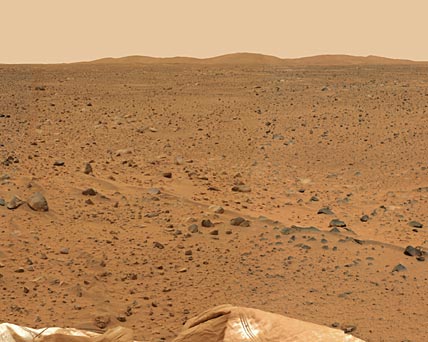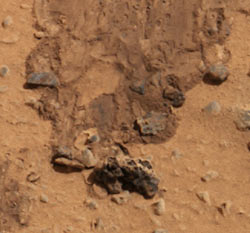
This near-true-color scene is part of the 360° panorama taken by Spirit's Pancam. The full image is a mosaic of 225 images taken through three color filters, painstakingly assembled by more than 25 scientists and engineers. It is 75 frames across and three frames tall; for larger views of the entire panorama, see NASA's Mars Exploration Rovers home page. The site in Gusev Crater is generally flat, but several small impact craters loom nearby. The hills are about 3 kilometers to the east; the highest peaks are about 100 meters tall. Many of the rocks are impact ejecta.
Courtesy NASA / JPL / Cornell University.
NASA’s intrepid Spirit rover remains in excellent health after its ninth day on the Martian surface. "The rover has to survive an incredibly large swing in temperature range each day," says project scientist Joy Crisp (Jet Propulsion Laboratory). Temperatures one meter above the ground at the landing site in Gusev Crater vary from a relatively balmy –10° Celsius (14° F) at 2 p.m. local time to a downright frigid –75° C (–103° F) just before sunrise. Nighttime temperatures will plunge to nearly –90° C (–130° F) over the next few months as autumn descends on Gusev Crater.
During a press conference on Monday, January 12th, science team geologist Michael Malin (Malin Space Science Systems) unveiled a spectacular, high-resolution 360° color panorama that showcases virtually the entire site within view of the rover. The image was taken by Spirit’s Pancam (Panorama Camera) during sols 3, 4, and 5 (a sol is a Martian day) and was assembled from 225 individual images. It is approximately true-color; if you were standing on Mars, you would see the landscape as darkish orange-brown. "It’s a great opening to the next stage of our mission, which is to get off the lander and start moving out into this field," says Malin.
Spirit is currently scheduled to roll off the lander early in the morning on January 15th (sol 12). "We’re about to kick the baby bird from the nest," says egress mechanical lead engineer Kevin Burke (JPL). This maneuver commenced Monday night when a pyrotechnic device fired to sever the cable connecting the rover to the lander, and the rover perfectly executed the first of three turns it needs to make before departing the platform.
Initially Spirit's suite of cameras and spectrometers will inspect nearby rocks and soil samples, but ground controllers will eventually direct the rover toward a 200-meter-diameter impact crater 250 meters to the northeast and then toward hills 3 kilometers to the east. The crater is a particularly attractive target because the impact that created it ejected rocks from as far down as 30 meters below the surface. As Spirit approaches the crater, it will encounter more and more ejecta, and these rocks could contain the chemical and mineralogical clues that Gusev Crater was once filled with liquid water.
The hills are also an attractive target, but mission principal investigator Steven Squyres (Cornell University) points out, "The hills are five times farther away than this vehicle was ever intended to go. I cannot tell you that we are going to reach those hills. We're going toward the hills. But even as we do, the view will get better and better." Even if Spirit doesn't reach the hills, it should encounter materials that originated in the hills.

The yellow line is a high-resolution infrared spectrum from Spirit's Mini-TES instrument; the red line is a spectrum taken from orbit by Mars Global Surveyor's TES instrument. The Mini-TES spectrum reveals the telltale signature of carbonates, minerals that may have formed in water. The yellow spike at far left is the signature of other minerals associated with liquid water.
Courtesy NASA / JPL / Arizona State University.
Scientists are particularly eager to investigate carbonates, whose signatures appear in high-quality infrared spectra taken by Spirit’s Mini-TES (Thermal Emission Spectrometer) instrument. On Earth, carbonates such as limestone often form in liquid water. But one of the biggest Mars mysteries deals with "missing carbonates." Orbital images show valleys that look like dry riverbeds, suggesting that liquid water existed on an early Mars that had a thicker atmosphere and a warmer climate. If true, large quantities of carbon dioxide should have dissolved out of Mars’s atmosphere into the water and chemically reacted with other materials to form carbonates. But orbital data from Mars Global Surveyor’s TES instrument reveal much lower carbonate abundances than predicted.
The carbonates seen by Mini-TES could have formed inside the crater if it once harbored a lake, or they could have formed when dust particles reacted with traces of water vapor in Mars’s thin atmosphere. "What is this carbonate telling us? It could be telling us about interactions with the atmosphere, or it could be telling us about water in Gusev Crater. We don’t know which one it is, but the beauty of this is that we know how to find out," says Squyres.
Spirit’s spectrometers will analyze a variety of rock and soil samples to see if carbonates are concentrated in they fluffy surface dust or in coarser dust grains and underground sediments. According to Squyres, the former scenario would favor the atmospheric model, because winds easily could have transported fine dust to Gusev Crater. But the latter scenario would favor the liquid-water hypothesis because the carbonates would be intrinsic to the site.
Mini-TES has also recorded the spectral features of other minerals associated with liquid water. "We have known from orbit that these types of minerals exist on Mars," says Mini-TES principal investigator Phil Christensen (Arizona State University). "But to have the ground underneath us containing minerals that have water bound in them, things like possibly clay minerals, is incredibly exciting. . . . To be able to do mineralogy from five feet away is fantastic."

Spirit's Pancam zooms in to reveal scrape marks in 'the Magic Carpet' from a retracting airbag. The Magic Carpet consists of fine-grained material easily disrupted by the retracting airbag. Such material acts almost like a liquid.
Courtesy NASA / JPL / Cornell University.
Scientists are also eager to inspect a patch of soil affectionately dubbed "the Magic Carpet" just 3 meters from the lander. It consists of soft material whose fine grains were easily dragged when an airbag retracted.
"What’s so fascinating about this is that it doesn’t exhibit the brittle deformation exclusively that you saw at the Pathfinder and Viking sites, but instead we see a more ductile, plastic form of deformation," says science team member John Grotzinger (MIT). Spirit’s Mössbauer and Alpha-Particle-X-Ray spectrometers will be able to test the magic carpet to see if it contains clay minerals.
"We don’t have enough time to go to all the places that are very exciting," adds Malin. Spirit’s mission is expected to last as long as the batteries can generate sufficient energy to power the rover’s systems, which should be about 90 days.
Spirit’s identical twin, Opportunity, will land on the opposite side of Mars in Meridiani Planum at 12:05 a.m. Eastern Standard Time on January 25th.
 0
0
Comments
You must be logged in to post a comment.